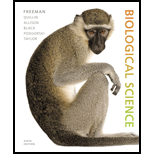
Concept explainers
Introduction:
Phototropism is a mechanism that is mostly seen in the plants. In this mechanism, the plant responds to the light stimulus.
Answer to Problem 1TYK
Correct answer:
Phototropism is the growth of an organism toward a light source (positive phototropism) or away from a light source (negative phototropism). In phototropism, the cells located on the shaded side of a stem elongate more than cells on the illuminated side of a stem.
Explanation of Solution
Explanation/Justification for the correct answer:
Option (c) is given that cells on the shaded side of a stem elongate more than the cells on the illuminated side of a stem during phototropism. The plant tip cells when exposed to light source sense light and release a chemical known as auxin. This results in the process of phototropism. It leads to the elongation of the cells that are far from the light. The shoot bends toward light and cells present in the shaded region of the stem elongate more. Hence, Option (c) is correct.
Explanation for incorrect answers:
Option (a) is given that cells on the illuminated side of a stem elongate more than the cells on the shaded side in phototropism. The cells present on the illuminated side, that is, those cells that are receiving the light, do not extend more. Actually, the cells that are present in the shaded region and are far from the light elongate more than those on the illuminated side due to the chemical auxin released by the cells, which causes phototropism. So, it is a wrong answer.
Option (b) is given that phototropism is triggered by red/far-red light. The bending of the plant occurs only toward the light that includes blue wavelength. Plants have a phototropic response when the blue wavelength is available, which falls in the visible range. Therefore, it is not necessary that phototropism is triggered due to the red or far-red light. So, it is a wrong answer.
Option (d) is given that phototropism is triggered by phytochrome. Phototropism is triggered by a chemical named auxin. This chemical is produced by the cells that are present in the shaded region of the stem, thereby inducing phototropism. So, it is a wrong answer.
Hence, options (a), (b), and (d) are incorrect.
Phototropism refers to the orientation of the plant in response to the light. Cells that are present on the shaded side of the stem extend more than cells that are present on the illuminated side of the stem.
Want to see more full solutions like this?
Chapter 37 Solutions
Biological Science (6th Edition)
- please fill in the empty sports, thank you!arrow_forwardIn one paragraph show how atoms and they're structure are related to the structure of dna and proteins. Talk about what atoms are. what they're made of, why chemical bonding is important to DNA?arrow_forwardWhat are the structure and properties of atoms and chemical bonds (especially how they relate to DNA and proteins).arrow_forward
- The Sentinel Cell: Nature’s Answer to Cancer?arrow_forwardMolecular Biology Question You are working to characterize a novel protein in mice. Analysis shows that high levels of the primary transcript that codes for this protein are found in tissue from the brain, muscle, liver, and pancreas. However, an antibody that recognizes the C-terminal portion of the protein indicates that the protein is present in brain, muscle, and liver, but not in the pancreas. What is the most likely explanation for this result?arrow_forwardMolecular Biology Explain/discuss how “slow stop” and “quick/fast stop” mutants wereused to identify different protein involved in DNA replication in E. coli.arrow_forward
- Molecular Biology Question A gene that codes for a protein was removed from a eukaryotic cell and inserted into a prokaryotic cell. Although the gene was successfully transcribed and translated, it produced a different protein than it produced in the eukaryotic cell. What is the most likely explanation?arrow_forwardMolecular Biology LIST three characteristics of origins of replicationarrow_forwardMolecular Biology Question Please help. Thank you For E coli DNA polymerase III, give the structure and function of the b-clamp sub-complex. Describe how the structure of this sub-complex is important for it’s function.arrow_forward

 Biology (MindTap Course List)BiologyISBN:9781337392938Author:Eldra Solomon, Charles Martin, Diana W. Martin, Linda R. BergPublisher:Cengage Learning
Biology (MindTap Course List)BiologyISBN:9781337392938Author:Eldra Solomon, Charles Martin, Diana W. Martin, Linda R. BergPublisher:Cengage Learning Biology: The Dynamic Science (MindTap Course List)BiologyISBN:9781305389892Author:Peter J. Russell, Paul E. Hertz, Beverly McMillanPublisher:Cengage Learning
Biology: The Dynamic Science (MindTap Course List)BiologyISBN:9781305389892Author:Peter J. Russell, Paul E. Hertz, Beverly McMillanPublisher:Cengage Learning Concepts of BiologyBiologyISBN:9781938168116Author:Samantha Fowler, Rebecca Roush, James WisePublisher:OpenStax College
Concepts of BiologyBiologyISBN:9781938168116Author:Samantha Fowler, Rebecca Roush, James WisePublisher:OpenStax College Biology Today and Tomorrow without Physiology (Mi...BiologyISBN:9781305117396Author:Cecie Starr, Christine Evers, Lisa StarrPublisher:Cengage Learning
Biology Today and Tomorrow without Physiology (Mi...BiologyISBN:9781305117396Author:Cecie Starr, Christine Evers, Lisa StarrPublisher:Cengage Learning





